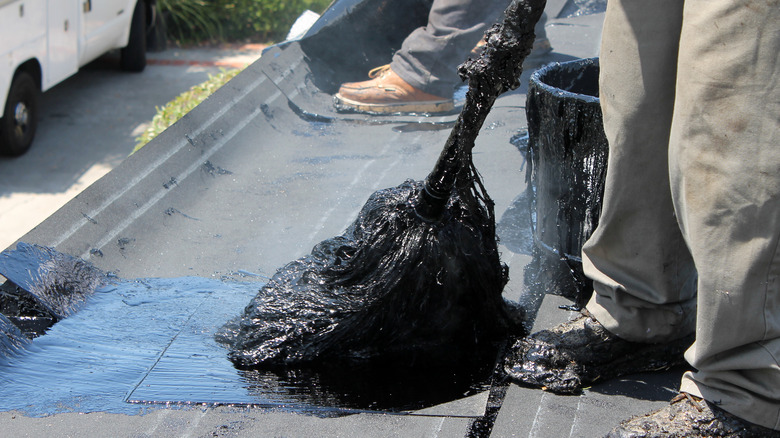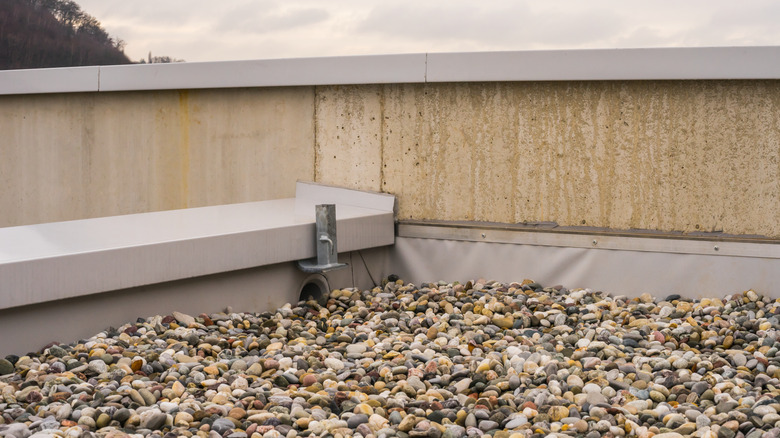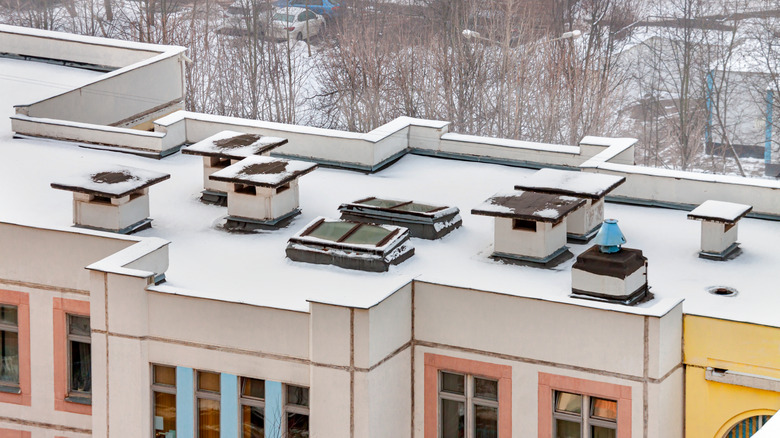What Is Tar And Gravel Roofing And Is It A Good Choice For Your Home?
Today's homeowners aren't at a loss for choices when it comes to roofing. Among the different types of roofs to consider is tar and gravel roofing, a type of built-up roof (BUR) system using a customizable sandwich of 3 to 5 laminated layers of hot tar, roofing felt, and asphalt sheets. Tar and gravel roofing dates back to 4,000 B.C., when it was used in Mesopotamian homes to protect from the desert environment. Today, it continues to provide energy-efficient roofing due to its heat-reflecting properties.
The first step in laying a gravel roof is applying the tar or asphalt. Then come multiple layers of roofing felt, followed by bitumen — a crude oil byproduct used for waterproofing and binding — and finally, the gravel. It's often seen on commercial buildings, but residential properties can also benefit. Choosing this roofing installation depends on your home design, as too much of a roof slope makes it easy for gravel to slide off and a bit more complicated to install.
A new roof can be expensive, but this choice is kind on your wallet, as the average cost for a new tar and gravel roof in 2024 is anywhere between $7,500 and $13,000. That breaks down to $2.50 to $4.50 per square foot on a typical 3,000-square-foot roof. However, your wallet can take an additional hit if you don't prepare the roof for heavy rain. From the cost benefits to the woes of the high potential for water damage, here are elements to consider in the debate over a tar and gravel roof.
Pros and cons of installing a tar and gravel roof
Constantly repairing or installing a new roof can be timely and costly for any homeowner. With a well-installed and maintained tar and gravel roof, you may have protective covering over your home for as much as 30 years. Its longevity is partly due to its resistance to UV rays and fire. Installation is budget-friendly, and keeping up with timely maintenance, which is minimal, is also cost-effective. Energy efficiency is a concern for many homeowners. Luckily, using gravel provides natural reflection from heat and UV rays, allowing you to cut down on cooling costs if you live in a hot environment.
The alternating layers of roofing materials create sturdiness when well constructed. However, the materials also make for a heavy roof. Therefore, you may have to spend extra to ensure your structure can support this type of design. Moreso than other roof types, it may also be difficult to find the source of a water leak because of the several layers involved. The stratum of material can make repair equally tricky. Untended leaks can damage your home structure and hit your budget, especially if mold forms. What about solid drainage? Without it, ponding can result when water collects after heavy rains. Water can further cause early deterioration from vegetation growth and moisture. Do you pride yourself on being eco-friendly? Unfortunately, this roofing material isn't recyclable.
Ideal conditions for tar and gravel roofing
Be mindful that this material is best suited for a flat or low-slope roof. An extreme slope makes it easy for the gravel to slide off or wash away. Can this roofing hold up under different moisture conditions? Sure, however, due to the flat nature of the slope it's usually on, environments prone to heavy rain and snow aren't ideal. Without proper winterizing of your flat roof, ice and snow quickly accumulate, making the roof heavier and causing structural concerns for homeowners. On the other hand, extreme direct sun can soften those layers of tar, which may prompt the gravel replacement every few years. So, consider your climate before choosing this material for a flat roof.
Despite its energy efficiency in reflecting heat, tar and gravel roofing doesn't have the best insulation quality, but you can fix that. Fiberglass, which protects from leaks and builds strength, or foam layers, which provide twice as much thermal resistance as similar materials, work well with this type of roofing to create a more secure covering. What do you plan to use your flat roof for? Will it be a place for rooftop parties, meetings, or other activities that create lots of foot traffic? If so, this may not be the best material, as the gravel will eventually shift and expose the underlying layers. Then, your roof may become vulnerable to cracks from UV rays or water damage from leaks. With this information in mind, you can decide if tar and gravel roofing is the ideal choice for you.


